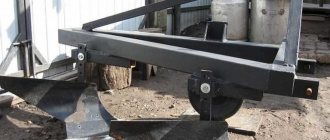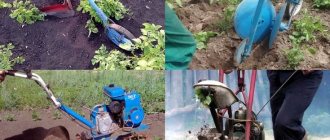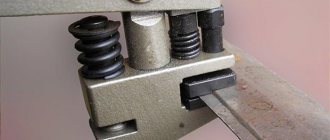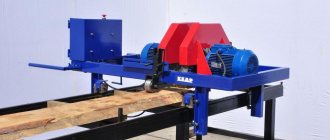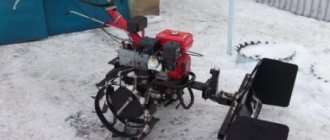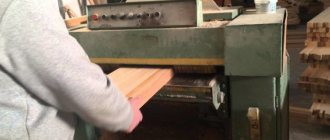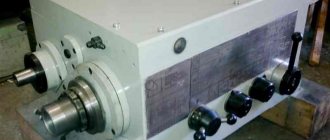A plow is a tool designed to plow the soil and raise virgin soil. It was invented back in the 3rd century BC. Subsequently, the design was seriously modified, including the material - if previously wood was used, then they switched to metal. You can buy a plow ready-made - fortunately, there are no problems with supply now. However, the quality of such products (both domestic and Chinese) leaves much to be desired. Some people decide to make a plow for a walk-behind tractor with their own hands - this will cost much less. In addition, if you make a reversible plow with your own hands, it will be much stronger and more reliable than a factory one.
Do-it-yourself manual plow. Housings
According to the number of bodies, plows are single-body, double-body and multi-body. The body consists of several parts:
- rack;
- working surface - ploughshare and blade;
- field board.
Body with share and blade
The ploughshare and blade are the working surface - this part is responsible for the quality and type of plowing. The soil layer is cut with a ploughshare, along which it rises to the dump. Here the soil crumbles and turns over. The degree of formation rotation depends on the shape of the dump. A field board is attached to the bottom of the body. Its task is to prevent the plow from moving towards the already plowed area.
If you are going to make your own plow, you need to choose a design based on the type of soil you are going to cultivate. Plow bodies are:
- Dump. For plowing with full or partial rotation of the formation. Such plows promote soil formation (grown plants are cut and placed at the bottom of the furrow, where they rot), and enrich the soil with oxygen (due to loosening).
- cultural - used for long-cultivated lands, crumbles the soil well, wraps to a medium degree;
- semi-screw moldboard bodies are used for cultivating virgin soil, plowing heavily turfed soil, it wraps the soil well, crumbles it moderately (models with an elongated feather wrap the layer completely);
- screw - good for cultivating virgin soil - the layer is completely wrapped;
Types of plowshare plow bodies
- Dumpless. Used in arid climates to conserve moisture and in regions at risk of wind erosion.
- Cutout. Suitable for soils with a small arable horizon. The lower part is only loosened, without rising outward, the upper part is removed and thrown onto the previous furrow, in which lies the podzolic layer loosened during the previous pass.
- With subsoiler. They are mainly used on marginal lands. The subsoil loosens the podzolic layer, which helps to increase the thickness of the fertile layer.
- With retractable chisel. Use on clay, loam, soil with a lot of stones. A chisel mounted on a stand in front of the plowshare prevents damage to the cutting edge. As grinding progresses, the chisel is pushed forward - for this there are special holes on it.
- Disk. It is used to treat waterlogged soils; it is also good when there are a large number of roots.
Tractor disc plow
How to install a plow on a walk-behind tractor
Before you begin setting up and installing the plow, you need to prepare the walk-behind tractor itself. The installation begins with the installation of the walk-behind tractor at the work site, the wheels are dismantled and the lugs are installed. (See Do-it-yourself lug lugs for a walk-behind tractor). The lugs give the walk-behind tractor better grip on the soil, eliminating slipping.
Next, we begin the installation; it is recommended not to tighten the nuts too much, for further adjustment if necessary. Then he fixes the hitch to the mounting system of the walk-behind tractor with two steel pins. After completing these manipulations, you can begin adjusting the plow.
Hand hiller. Manual potato hiller
Potatoes have always been considered one of the main vegetables in the kitchen. It is used for preparing first and second courses, desserts, etc. Growing this vegetable requires a lot of labor, because to get a good harvest you need to hill up the potato bushes several times a season.
Thanks to hilling, oxygen access to the roots improves, channels in the ground are destroyed, as a result of which less moisture evaporates, and the number of tubers increases.
Hilling up bushes is carried out in summer cottages mechanically using a hoe. However, this is a long and difficult process.
To help farmers and gardeners specializing in growing potatoes, a special tool called a hiller has been created.
Advantages and disadvantages of hillers
The use of mechanisms always allows you to increase labor productivity on farms and summer cottages.
Manual hiller
Advantages:
- reduces labor costs and increases farmer efficiency;
- can be a multifunctional tool that can additionally be used for loosening the soil, planting potatoes, and also during harvesting;
- in order to use the device, you need to purchase it, which means that material costs will be required for the purchase and further maintenance;
- When working with the device, you must follow safety regulations.
Flaws:
Types of potato hillers
Depending on the design, the following types of devices are distinguished:
Disc hiller
Propeller mechanisms make it possible to move the soil between the rows into the furrows.
The most common are lister and disk devices.
Lister mechanisms
Interesting! Devices of this type are available with a fixed working width. Otherwise they are called plows, as they look like a plow.
They are produced with an adjustable angle of attack (the angle of inclination of the cutting part of the hiller to the ground) and fixed.
Adjustable ones allow you to change the depth of loosening and, accordingly, the gripping area.
Advantages of the device:
- consumes less energy compared to disk devices;
- simpler in design;
- the price is less than for a disk device;
- It is light in weight, so it works great on low-power machines (walk-behind tractors and cultivators).
Lister hiller
Flaws:
- does not work well on wet and heavy soil;
- Potato planting should only be level, with strictly fixed row spacing.
Disc hillers
Structurally, they consist of two disks with a sharpened edge. As the hiller moves, the discs rotate and crush the soil. They have a convex shape. Due to this shape, the soil is simultaneously loosened and an earthen ridge is formed.
The disks are attached through ball bearings to the racks, which are located on a horizontal holding frame.
Note! They can be adjusted vertically, less often horizontally. With vertical adjustment, the angle of rotation of the disks changes, due to which the amount of earth needed to form the ridge also changes. Horizontal adjustment moves the discs vertically (raises or lowers). In this way, the angle of attack is adjusted.
Advantages:
- better performance of hilling, the ridges are smoother and higher;
- can be used with different row spacings;
- allows hilling on heavier soil.
The disc hiller can be used with different row spacings
Flaws:
- higher price;
- higher fuel consumption.
Depending on the volume of work performed and the degree of mechanization, the potato hiller can be:
- manual;
- automated.
Fact! Manual - designed to perform only hilling, automated - used to perform several types of work: hilling, loosening, planting, harvesting.
Manual - moves due to the fact that a person pushes or pulls the mechanism.
An automated potato hiller is an additional hanging device for a walk-behind tractor, cultivator or tractor.
Manual potato hiller
Allows you to process potato beds, regardless of the presence of a walk-behind tractor or a tractor. For manual types, the most common designs are lister and disk mechanisms.
How to do it?
Modern models of walk-behind tractors can be equipped with a reliable plow made by yourself. Varieties of this element: double-turn, reversible, two-body, rotary or Zykov’s product. There are quite a lot of design options. There are even options in which the body is made of a gas cylinder. It’s not difficult to make a high-quality plow for motorcycles yourself if you follow certain rules.
Rotary
The manufacturing of the structure can be divided into several main stages.
Prepare a good dump in the shape of a cylinder. This must be done exclusively in accordance with the drawing. The part is made of alloy metal
It is important to follow the drawing when making the structure yourself. They put out the ploughshare. The wedges are inserted into the iron sheet (3 mm) at an angle of 45 degrees. Connect the ploughshare to the shield on the side
Be sure to ensure that the blade of the ploughshare is located just below the shield itself (1 cm, no more). Attach the blade to the ploughshare. The working half with the ploughshare is welded to the metal tube, which serves as the base, using a welding machine. On the opposite side - fasteners for motorcycles. When the plow is ready, you can weld an axle with wheels in its lower half.
Turning
The rotating type of plow is rightfully recognized as one of the most functional and practical. This design is an excellent assistant for plowing land on a site, because it can cover a fairly large area. The plow is also good because you don’t have to waste time with it after each approach. You will only need to turn the plow and move in the opposite direction. The productivity of equipment will increase significantly. The main actions are performed in the same way as in the case of a rotary mechanism, but in this case the cutting elements must be below the skid (at least 2 cm).
Disk
It is possible to assemble a disc plow for machinery with your own hands. A similar model is assembled from the following parts:
The disks for the device can be taken from an old “seeder”, if you have one in your arsenal. These elements are installed at an angle to increase work productivity. The hiller is hung on the equipment through the coupling bracket. The T-shaped leash from the plow is screwed to it using bolts and a stopper. At impressive speeds, the hiller may begin to slip, so you will have to work exclusively at low speeds or with twin wheels.
Do-it-yourself manual plow for planting potatoes. Planting plow
A hand plow will help you plant potatoes without a shovel. To make it yourself, you will have to put in some effort. But they are worth spending, since the device turns out to be universal - the plow is used not only for planting potato beds, but also for subsequent hilling of bushes and loosening row spacing.
Since hollow pipes and sheet metal are used in the manufacture of the structure, you will need welding equipment, a gas torch or blowtorch, and an angle grinder.
To create a universal method of planting potatoes, follow this algorithm:
- a meter pipe with a diameter of 2.5 cm is filled with sand and closed with plugs;
- bend at an angle of 10-15 degrees at a distance of 30 cm from the edge, using a blowtorch; a stand is obtained, indicated in the drawing by position 3;
- Having removed the plugs, pour out sand (it is only necessary for neat bending of the pipe);
- a double-blade working element with a trimming knife is formed from pieces of metal and secured from the bottom of the rack with bolts, for which holes are pre-drilled in the pipe;
- control handle 4 is inserted into the pipe from above and secured with bolt 12; there should be several holes on the handle to create a telescopic retractable system;
- the front link 5 is shaped as shown in the drawing and welded to the rack; positions 9, 10 indicate the presence of a horny handle;
- Using brackets 7 and 8, a lanyard 6 is attached to the rod and riser, allowing you to adjust the level of attack of the knife.
Manual plow with traction
For ease of control of the plow, a strong neck-axillary tape can be attached to the base of the draft handles (position 11). It will allow the lead worker to evenly distribute his efforts when walking with the plow across the site.
Homemade plow: existing types, their pros and cons, manufacturing technology
Cultivation of land is the most labor-intensive task for rural residents and summer residents. Preparing the soil for sowing and cultivating the land after harvesting are the most difficult types of manual work. A plow can greatly facilitate the performance of these works.
A plow is an agricultural tool with a wide metal blade that is used to plow the ground. In addition to tillage, plows are used for underwater work, for laying cables, and when searching for oil.
At the first stages of using the plow as an agricultural tool, people dragged it behind them , a little later they began to use livestock (oxen, horses) for this, today this hard physical work has been transferred to agricultural machinery - the tractor.
The main task of this tool is to turn over the top layer of soil. This procedure (ploughing) largely frees the soil from weeds. During the plowing process, the root system of weeds that have already begun to grow, but are not yet strong enough, is damaged.
In addition, along with the overturned layer of earth, the seeds of weeds that have not yet germinated are moved deep into the soil, which, of course, complicates their further germination. Many weed seeds are completely destroyed during the plowing process.
During the plowing process the soil loosens , becomes softer and more pliable, which subsequently makes sowing more effective and has a good effect on the germination of cultivated plants.
Modern agriculture uses different types of plows to cultivate the soil. These agricultural implements differ according to two characteristics:
- by aggregation method;
- according to the method of plowing.
According to the method of aggregation, plows are trailed, mounted and semi-mounted. Each type has its own advantages and disadvantages.
The trailed plow can only be driven using transport wheels. It is rarely used in modern agriculture, because the majority of tractors are equipped with a mounted system with a built-in hydraulic cylinder.
The advantages include the fact that, according to agronomists, after cultivating the soil with a trailed plow, the arable land is smoother and more uniform.
The disadvantage of such a tool is the rather large rotation angle, which prevents the use of this plow along with mounted and semi-mounted ones in the same paddock.
Manual hiller for potatoes. Homemade manual hiller from a bicycle
It is very difficult to hill up potatoes and beds with your own hands, but a homemade hiller makes life much easier for the farmer. The scheme for creating the unit is very simple.
Operating principle
The key part of a manual hiller is the cultivator or plow. It is he who will do what is done manually with a hoe or hoe - plow the soil. This plow, using its sharp end (“nose”), digs slightly into the soil and distributes it on its sides, covering the potato rows with soil.
If the hiller is a homemade model made from a bicycle, then the cultivator will be mounted on its frame. By slightly changing the structure of the unit, grabbing the steering wheel, you can control the device, directing it in the desired direction. The movement of the hiller itself is carried out due to a single wheel in the front part of the frame.
The essence of the work of a manual hiller can be summarized more briefly using the following algorithm:
- the cultivator crashes into the ground;
- the operator of the apparatus, using the steering wheel, directs the hiller in the desired direction and moves it forward;
- movement is carried out due to the existing wheel.
What is needed to create a hiller?
First of all, you will need certain equipment and materials:
- frame of an unnecessary bicycle (necessarily with a handlebar and one wheel 26-28 inches);
- welding fixtures;
- wrenches for nuts and bolts (if the cultivator will be screwed to the mount).
At the same time, you will need a little patience and the ability to work with a welding machine.
Preliminary actions
To begin with, prepare the bicycle frame: handlebars, saddle, pedals, and remove the rear wheel. The second wheel is disassembled and cleaned - only a metal rim is needed.
The metal rim penetrates the soil better, which is why the hiller will gain much greater stability and maneuverability than with rubber. Operating such a unit will become much easier.
The process of creating a hiller
The manufacturing process can be divided into 5 stages:
- The mount on the rear wheel is cut so that in the end there is only a “triangle” from the bicycle frame.
- The cultivator will be placed instead of the wheel, and it must be fixed there.
- Screw or weld the cultivator.
This should be done efficiently, because this part of the hiller will bear the greatest load. If the cultivator will be screwed on, then tighten the nuts as tightly as possible, otherwise the manual hiller will not last even a couple of days. This is where both nut and bolt wrenches come in handy. By operating them simultaneously, you will be able to secure the parts firmly and for a long time. - Next, the offset of the cultivator is adjusted (how far/close it is). This is done for the purpose of convenience during the hilling process, so as not to trip over the cultivator blades.
- The previously removed steering wheel is tightly twisted in place of the saddle.
Creation of a cultivator section
Creating a basic cultivator is quite simple. In fact, this is the same plow. Two plates are attached near the base, which form an angle directed forward (towards the wheel). As the hiller moves, the plates will divide the soil into 2 parts and hill up the potato rows with the raised soil.
However, the following requirements for this part should be adhered to:
- the total width of the blades should be equal to 2/3 of the row spacing of the potato bushes;
- the cultivator should go 10-15 cm underground;
- The angle of the blades should be close to 90 degrees - this way they will perfectly pick up the soil.
After carrying out a full range of work, you should end up with a full-fledged manual hiller that does its job perfectly while growing potatoes.
To familiarize yourself with the device in more detail and understand how to properly make such a homemade hiller, you can see the following
Useful tips
If you operate the hiller together, the hilling process will be significantly simplified and the efficiency of the work done will significantly increase. To operate a manual hiller in pairs, you need to attach a regular belt to the front of the unit.
You can attach some kind of weight to the back. This improves penetration into the ground, which, again, increases work efficiency. But at the same time, it will be more difficult for such a unit to move forward due to the increase in mass.
Other types of hillers
There are many schemes for creating hillers. Next we will consider other methods.
From a bicycle wheel and fork
If you have a front bicycle fork and a wheel for it, then you can create a hiller using the following technology:
- 2 pipes need to be welded at an obtuse angle;
- a bicycle handlebar is attached to a long pipe (it would be wiser to weld it so that it does not fall off during operation);
- A cultivator is attached/welded to the junction of both pipes, below.
The final output will look like this:
Creating such a hiller is much simpler than the one mentioned earlier. However, different types of units should be used for different purposes.
Useful tips and tricks
If you decide to build a good plow for a walk-behind tractor with your own hands, then you should listen to useful recommendations from experienced craftsmen.
If you plan to build a double-furrow plow, then you should remember that it must have two shares. This device can be used for plowing various types of soil.
This is the best specimen for working with stagnant soil. When making a rotary plow, it is very important to ensure that the edges of the moldboard and the ploughshare coincide. These elements are connected as tightly and firmly as possible
There should be no gaps or noticeable cracks. After using the plow, it must be cleaned of any dirt and adhering particles. Only if this rule is observed can we talk about the durability of the structure and its wear resistance. And then you won’t have to constantly sharpen the cutting plate. It will be much more convenient to install the plow on the agricultural machinery itself if you place the walk-behind tractor on stands. These can be not only special supports, but also simple bricks or stones/boards. Particular attention is paid to the already constructed plow. If it has only one bolted connection and only one hole, then it will not be adjustable.
It is advisable to assemble a plow with a support wheel on a steel sheet. All surfaces will need to be cleaned and polished. The back surface of the welded share is made as smooth as possible. Popular rotary plow types are in most cases made with disk mechanisms, but there are also drum, shovel and auger types. Such structures are simply irreplaceable when applying fertilizers and controlling weeds. For independent work, it is advisable to use only high-quality plumbing tools. You need to be able to work with them. At least minimal experience is required. Do not forget to process the working edge of the manufactured plow from time to time.
This will make her work more efficient. When making your own plow for a walk-behind tractor, it is important to strictly adhere to the chosen technology and the drawings drawn up. The slightest mistake or omission, which may seem insignificant, can lead to poor quality work of the structure.
Then it will need modification.
If you have doubts that you will be able to assemble the plow yourself, then it is better not to risk it and purchase a ready-made option. Fortunately, many companies offer high-quality and durable designs at different prices. You can buy them in specialized stores or order online.
To learn how to set up a plow for a walk-behind tractor, see the following video.
Do-it-yourself manual plow drawings. DIY hand plow
When planning to make a plow, you must first decide what type of soil you will have to plow with the unit and the type of crop you are going to grow.
During operation, the body of the unit experiences enormous loads, its working surface is exposed to the abrasive effects of the soil. Therefore, for the manufacture of working parts, it is necessary to use steel metal with a thickness of 3-5 mm.
It is advisable to provide a removable design of the ploughshare, so that it can be sharpened.
Considering all these properties of equipment operation, you can begin manufacturing a carbon steel blade. You can do this in three main ways:
- If the surface of the dump is cylindrical, then it is better to use sheet-bending equipment to produce a workpiece of the desired shape. A steel workpiece, cut by gas welding or metal shears, is fed to sheet metal bending equipment at an angle of 23-25 degrees and bent. Then the finishing is carried out strictly according to the template, which is pre-cut from thick cardboard.
- A metal pipe with a diameter of 55–60 mm and a wall thickness of 4–5 mm is also suitable for the manufacture of the unit. Cut out a template from cardboard, place it on the pipe and mark the dimensions. Treat with a hammer and, if necessary, fine-tune with sandpaper.
- This method is the most time-consuming and requires special skill. The workpiece is preheated in any way, but preferably in a forge, and then bent along a matrix.
The unit body is made of sheet steel with a thickness of at least 3 mm.
Experienced craftsmen recommend cutting out all the parts from cardboard and gluing them together, maintaining all sizes and angles. Only after you are completely satisfied with the cardboard model can you begin metal work.
Single body plow model
Such models have the simplest design. Looking at a photo of a homemade plow, which belongs to the single-hull category, you can see that it only includes a ploughshare.
Suitable only for soils that are light. It is impossible to use it for working in virgin lands or, for example, in difficult soil.
There is also a type of plow consisting of two bodies. They look like two frames that are fastened together, and this design is also topped with plowshares.
This type not only plows, but also harrows the soil. At the same time, the quality of soil cultivation increases significantly.
What are the advantages of a manual cultivator?
Today, mechanical hand cultivators are poorly represented in advertising and on the Internet. The reason is their low cost. Much more emphasis is placed on motorized devices. However, the power and productivity of the latter is often excessive, especially for owners of small plots.
Getting by with a standard shovel is quite difficult and takes a long time: you need to have not just strength, but also excellent health, which is often lacking for pensioners, who are the most common owners of small summer cottages. The use of manual devices greatly simplifies the work, but at the same time does not hit the wallet as much as gasoline or diesel tools.
In addition, hand-held devices are very environmentally friendly. They use the simplest physical principles of force redistribution, such as a wheel, lever, gate, block, inclined plane and others. There is no noise, no exhaust gas emissions, and manual cultivators are much less prone to breakdowns. This is due to the minimum of components and simple connecting nodes.
The hand-held cultivator is always ready to work - it does not need an electrical outlet or fuel. Its storage conditions are an ordinary dry shed. For the minimum of problems and maintenance, it is loved by summer residents, gardeners and gardeners.
Kinds
The design of manual soil cultivators is often quite simple. The purpose of this garden tool is to loosen the soil to aerate it and facilitate root growth, as well as better access to water when watering. The second function is the removal of ubiquitous weeds. And here a manual cultivator will give a hundred points ahead to a gasoline device.
It is simply impossible to squeeze through narrow row spacing with bulky attachments of a motorized unit. A compact hand-held device can cope with the task, and your hands will not experience vibrations that are dangerous to the musculoskeletal system.
The simplest manual ripper
This is a very simple and accessible tool. It consists of a rod mounted on a handle of varying length, from which extend three or more round-shaped curved “claws” with small triangular attachments at the ends, like a hook. Despite the primitive design, this ripper is quite effective. With its help, you can easily and simply pick up pieces of soil that have dried on the surface, and by dragging the tool along the ground with slight pressure, you achieve shallow furrows sufficient for regular occasional loosening.
Among the standard rippers there are both nameless models and those produced under brands such as Gardena.
Star cultivator
The popular name perfectly reflects the essence of this simple garden tool. In stores and reference books it is most often called rotary, since its action is based on a block of rotating sprockets made of durable hardened metal. The sprockets are mounted on an axis, sharpened and slightly turned out in order to simultaneously easily penetrate the soil and slightly turn it out.
Often a movable rectangular bracket is installed behind the sprocket block. When the gun moves forward, it becomes at a right angle to the frame, and when it moves back, it folds, taking part of the earth with it. If you sharpen such a frame, it cuts weeds well. In general, the tool is excellent for combined loosening and weeding.
Cultivator GRINDA 8-421888
Classic rotary cultivator with six stars. To improve loosening, the rays of the rotating mechanism are made transverse - this way they capture more soil, turning it outward. Three holders have screws for securing the star bits, of which there are two per holder. The kit includes a plastic rubber-coated handle of a short format, but you can use a screw to attach the cultivator to a long handle.
Manual cultivator Wolf Garten DA-S
This cultivator has four stars, the beams are flat, longitudinal, converging into a cone - this makes the work easier and ensures a gentle effect on the soil. Behind the sprocket block there is a bracket for removing weeds and distributing soil masses. The tool is made of stainless steel, which ensures long service life and absence of corrosion.
Flat cutter (Fokina ripper)
The simplest device that you can either buy at a garden store or make with your own hands. In appearance, it is very reminiscent of the hoe (hoe) common in the southern regions of Russia, that is, a blade curved at a right angle to the handle. A distinctive feature is a narrow blade, the width of which is comparable to the thickness of the handle and is 3 - 5 cm, as well as an oblique cut of the blade.
Thanks to its specific shape, a flat cutter is very convenient for doing small work, for example, removing weeds in the root zone of adult tomatoes, cabbage, peppers, and also weeding narrow rows in a greenhouse.
Manual cultivator "Tornadika" (root digger)
The production of these tools is branded and is associated among summer residents with the name of the company. The device is very simple: a horizontal handle made of a perpendicular tube is mounted on a vertical handle on one side, and several (usually three) teeth spirally twisted counterclockwise on the other.
They work with a cultivator by placing it on the soil and rotating the handle. Thanks to this, two problems are solved at once: the compacted soil is loosened, and if there is a weed in the area where the tines move, it will be thrown to the surface, even if it has a very powerful root system.
The Tornadika cultivator is popular due to the fact that it is very easy to work with: the back remains straight, and the fairly long handles allow you to rotate the device with little effort, using the effect of a lever.
Ripper "Mole"
Sometimes this device is called a “miracle shovel” for its properties of simultaneously digging and breaking clods of earth. It consists of two parts connected in two places and rotating on a longitudinal axis relative to each other. One part resembles straight, wide views, and the second resembles a lattice with vertical bars.
During use, the “forks” are driven into the ground with a foot, like the bayonet of a shovel, and the lattice part rests on the surface of the soil. When you press on the cutting, the rods rise, pulling out a lump of soil. When passing through the grate, the lump breaks, leaving an effect similar to using a regular shovel complete with a rake.
Mini plow
The most advanced, heaviest and expensive type of hand cultivator. In fact, it is a miniature plow for working alone or with two people. There is a wheel installed in front, most often a steel one with a flat rim, on the axis of which a frame with two handles is mounted. By hanging various equipment on the frame - plows, moldboards, furrowers, flat cutters - you can significantly increase the pace of work.
Manual mini-plows are produced by small enterprises in Russia and Ukraine (trade names “Slobozhanka”, “Batrak”, “Vinnitsa”). It can be recommended for intermediate farms, where the area of land cultivation is not yet so large as to require the purchase of motorized equipment, but at the same time, processing with standard individual means is difficult and problematic.



